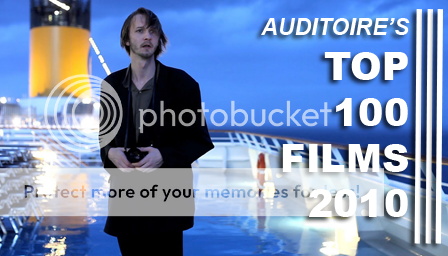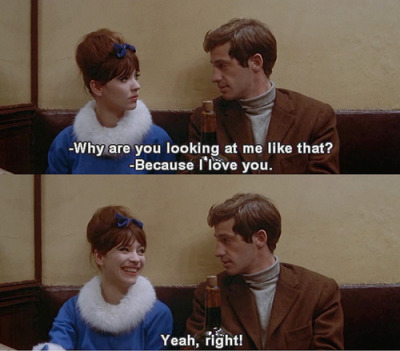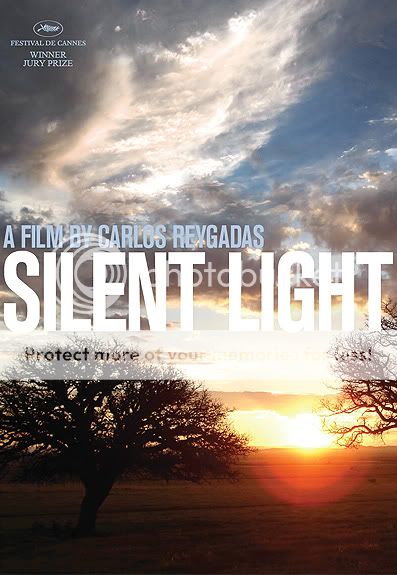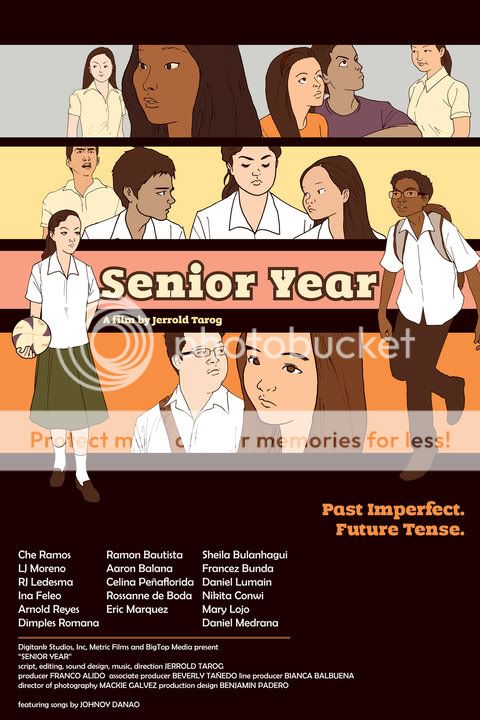...
 Avatar (2009) is James Cameron's most bloated movie ever. Titanic (1997) is bloated and so as the Terminator series. Fat movies and million-dollar productions promise two things: an explosion and a hellbent end-of-the-world scene. Both are present in Avatar, a one fat movie of the 21st century. Avatar created a large explosion of films rendered in 3D, its the stuff that pops out of the screen when you wear 3D glasses. Yeah, I guess you heard it somewhere. Anyway, Avatar is a gem in terms of its technical brilliance. I say nothing can match this invention of Cameron for being the first one to shot an otherworldly live-action film using a 3D Fusion Camera System. Its like using a digital camera, but the camera's projection is in 3D. In that way, the filmmaker can judge by aesthetics the look of the film during shooting compared with the conventional 3D ones done during post-production.
Avatar (2009) is James Cameron's most bloated movie ever. Titanic (1997) is bloated and so as the Terminator series. Fat movies and million-dollar productions promise two things: an explosion and a hellbent end-of-the-world scene. Both are present in Avatar, a one fat movie of the 21st century. Avatar created a large explosion of films rendered in 3D, its the stuff that pops out of the screen when you wear 3D glasses. Yeah, I guess you heard it somewhere. Anyway, Avatar is a gem in terms of its technical brilliance. I say nothing can match this invention of Cameron for being the first one to shot an otherworldly live-action film using a 3D Fusion Camera System. Its like using a digital camera, but the camera's projection is in 3D. In that way, the filmmaker can judge by aesthetics the look of the film during shooting compared with the conventional 3D ones done during post-production.
 Requiem for a Dream (2000) is a gem of a mysterious film about obsession, drug addiction, and self-ridicule. It touches themes about alienation and self-loathe. A psychological rift of a film, Aronofsky uses extreme expressionist aesthetics like wide-angle close-ups, splits screens, outlandish camera choreography, centered framing and a winning-performance of Ellen Burnstyn. The plot acclimates in a crescendo, punctuated by a repetitive taking-a-drug montage. His highly subjective compositions demands a lot of attention and analysis that this film might be one of his most important works.
Requiem for a Dream (2000) is a gem of a mysterious film about obsession, drug addiction, and self-ridicule. It touches themes about alienation and self-loathe. A psychological rift of a film, Aronofsky uses extreme expressionist aesthetics like wide-angle close-ups, splits screens, outlandish camera choreography, centered framing and a winning-performance of Ellen Burnstyn. The plot acclimates in a crescendo, punctuated by a repetitive taking-a-drug montage. His highly subjective compositions demands a lot of attention and analysis that this film might be one of his most important works.
 Begotten (1991) is a cockroach in a den. It is metaphysically sick, sloppy and eerie. Its darkness is unmeasurable and even unattainable in today's cinema. This is an Elias Merhige gem, a masterpiece and a landmark work of art in experimental cinema. One can look upon the history of the experimental genre: Maya Deren, the woman who got the balls, Jonas Mekas, Kenneth Anger, Andy Warhol, one can observe that this work is a temporal rift from the trend. Shot it black-and-white, it is reprocessed in film laboratory to attain the black-white-half-tone absent cinematography. The film is so perverse, so dark it rips the balls out of anyone else. Someone said it is equivalent to Samuel Becket's darkest parables. If one knows who Samuel Becket is, you'll picture it right away. WASAK is an understatement.
Begotten (1991) is a cockroach in a den. It is metaphysically sick, sloppy and eerie. Its darkness is unmeasurable and even unattainable in today's cinema. This is an Elias Merhige gem, a masterpiece and a landmark work of art in experimental cinema. One can look upon the history of the experimental genre: Maya Deren, the woman who got the balls, Jonas Mekas, Kenneth Anger, Andy Warhol, one can observe that this work is a temporal rift from the trend. Shot it black-and-white, it is reprocessed in film laboratory to attain the black-white-half-tone absent cinematography. The film is so perverse, so dark it rips the balls out of anyone else. Someone said it is equivalent to Samuel Becket's darkest parables. If one knows who Samuel Becket is, you'll picture it right away. WASAK is an understatement.
 Amores Perros (2000) marks Inarritu's beginning of his neorealist Death trilogy that would be celebrated internationally six year after the release of this debut. The film is a stand out for achieving a hard-boiled, macho-man atmosphere composed with depth, resonance and intensity. Its aesthetics emulates the key elements of Latin American filmmaking: fast and snappy editing and intensified color fields characteristic of films like Y tu mamá también (2001) by Alfonso Cuaron and City of God (2002) by Fernando Meirelles. The film's treatment of violence depends heavily in Inarritu's compositional style and staging strategies that without Inarritu's direction, this might turn out to be a misdirected action movie.
Amores Perros (2000) marks Inarritu's beginning of his neorealist Death trilogy that would be celebrated internationally six year after the release of this debut. The film is a stand out for achieving a hard-boiled, macho-man atmosphere composed with depth, resonance and intensity. Its aesthetics emulates the key elements of Latin American filmmaking: fast and snappy editing and intensified color fields characteristic of films like Y tu mamá también (2001) by Alfonso Cuaron and City of God (2002) by Fernando Meirelles. The film's treatment of violence depends heavily in Inarritu's compositional style and staging strategies that without Inarritu's direction, this might turn out to be a misdirected action movie.
 A Serious Man's (2009) ending is indicative of the Coen's confidence with their craft. Considered as two of the most enigmatic icons in movie history in terms of style and homogeneity, the Coens developed a provocative but diverse style through the years mixing different genres and techniques, each of their films exhibits a pluralistic take on cinema as filmmakers. The film, which was totally a different take from their previous No Country for Old Men (2008), is a unique attack on the suburban alienation, a black comedy rendered with a strangely diffuse visual but carefully composed structured shots, elegantly paced and conflict driven. The film conflates many issues about the black-comedy suburban genre that it questions its implosive stature as a trend.
A Serious Man's (2009) ending is indicative of the Coen's confidence with their craft. Considered as two of the most enigmatic icons in movie history in terms of style and homogeneity, the Coens developed a provocative but diverse style through the years mixing different genres and techniques, each of their films exhibits a pluralistic take on cinema as filmmakers. The film, which was totally a different take from their previous No Country for Old Men (2008), is a unique attack on the suburban alienation, a black comedy rendered with a strangely diffuse visual but carefully composed structured shots, elegantly paced and conflict driven. The film conflates many issues about the black-comedy suburban genre that it questions its implosive stature as a trend.
*****
 Requiem for a Dream (2000) is a gem of a mysterious film about obsession, drug addiction, and self-ridicule. It touches themes about alienation and self-loathe. A psychological rift of a film, Aronofsky uses extreme expressionist aesthetics like wide-angle close-ups, splits screens, outlandish camera choreography, centered framing and a winning-performance of Ellen Burnstyn. The plot acclimates in a crescendo, punctuated by a repetitive taking-a-drug montage. His highly subjective compositions demands a lot of attention and analysis that this film might be one of his most important works.
Requiem for a Dream (2000) is a gem of a mysterious film about obsession, drug addiction, and self-ridicule. It touches themes about alienation and self-loathe. A psychological rift of a film, Aronofsky uses extreme expressionist aesthetics like wide-angle close-ups, splits screens, outlandish camera choreography, centered framing and a winning-performance of Ellen Burnstyn. The plot acclimates in a crescendo, punctuated by a repetitive taking-a-drug montage. His highly subjective compositions demands a lot of attention and analysis that this film might be one of his most important works. Begotten (1991) is a cockroach in a den. It is metaphysically sick, sloppy and eerie. Its darkness is unmeasurable and even unattainable in today's cinema. This is an Elias Merhige gem, a masterpiece and a landmark work of art in experimental cinema. One can look upon the history of the experimental genre: Maya Deren, the woman who got the balls, Jonas Mekas, Kenneth Anger, Andy Warhol, one can observe that this work is a temporal rift from the trend. Shot it black-and-white, it is reprocessed in film laboratory to attain the black-white-half-tone absent cinematography. The film is so perverse, so dark it rips the balls out of anyone else. Someone said it is equivalent to Samuel Becket's darkest parables. If one knows who Samuel Becket is, you'll picture it right away. WASAK is an understatement.
Begotten (1991) is a cockroach in a den. It is metaphysically sick, sloppy and eerie. Its darkness is unmeasurable and even unattainable in today's cinema. This is an Elias Merhige gem, a masterpiece and a landmark work of art in experimental cinema. One can look upon the history of the experimental genre: Maya Deren, the woman who got the balls, Jonas Mekas, Kenneth Anger, Andy Warhol, one can observe that this work is a temporal rift from the trend. Shot it black-and-white, it is reprocessed in film laboratory to attain the black-white-half-tone absent cinematography. The film is so perverse, so dark it rips the balls out of anyone else. Someone said it is equivalent to Samuel Becket's darkest parables. If one knows who Samuel Becket is, you'll picture it right away. WASAK is an understatement. Amores Perros (2000) marks Inarritu's beginning of his neorealist Death trilogy that would be celebrated internationally six year after the release of this debut. The film is a stand out for achieving a hard-boiled, macho-man atmosphere composed with depth, resonance and intensity. Its aesthetics emulates the key elements of Latin American filmmaking: fast and snappy editing and intensified color fields characteristic of films like Y tu mamá también (2001) by Alfonso Cuaron and City of God (2002) by Fernando Meirelles. The film's treatment of violence depends heavily in Inarritu's compositional style and staging strategies that without Inarritu's direction, this might turn out to be a misdirected action movie.
Amores Perros (2000) marks Inarritu's beginning of his neorealist Death trilogy that would be celebrated internationally six year after the release of this debut. The film is a stand out for achieving a hard-boiled, macho-man atmosphere composed with depth, resonance and intensity. Its aesthetics emulates the key elements of Latin American filmmaking: fast and snappy editing and intensified color fields characteristic of films like Y tu mamá también (2001) by Alfonso Cuaron and City of God (2002) by Fernando Meirelles. The film's treatment of violence depends heavily in Inarritu's compositional style and staging strategies that without Inarritu's direction, this might turn out to be a misdirected action movie. A Serious Man's (2009) ending is indicative of the Coen's confidence with their craft. Considered as two of the most enigmatic icons in movie history in terms of style and homogeneity, the Coens developed a provocative but diverse style through the years mixing different genres and techniques, each of their films exhibits a pluralistic take on cinema as filmmakers. The film, which was totally a different take from their previous No Country for Old Men (2008), is a unique attack on the suburban alienation, a black comedy rendered with a strangely diffuse visual but carefully composed structured shots, elegantly paced and conflict driven. The film conflates many issues about the black-comedy suburban genre that it questions its implosive stature as a trend.
A Serious Man's (2009) ending is indicative of the Coen's confidence with their craft. Considered as two of the most enigmatic icons in movie history in terms of style and homogeneity, the Coens developed a provocative but diverse style through the years mixing different genres and techniques, each of their films exhibits a pluralistic take on cinema as filmmakers. The film, which was totally a different take from their previous No Country for Old Men (2008), is a unique attack on the suburban alienation, a black comedy rendered with a strangely diffuse visual but carefully composed structured shots, elegantly paced and conflict driven. The film conflates many issues about the black-comedy suburban genre that it questions its implosive stature as a trend.*****














































